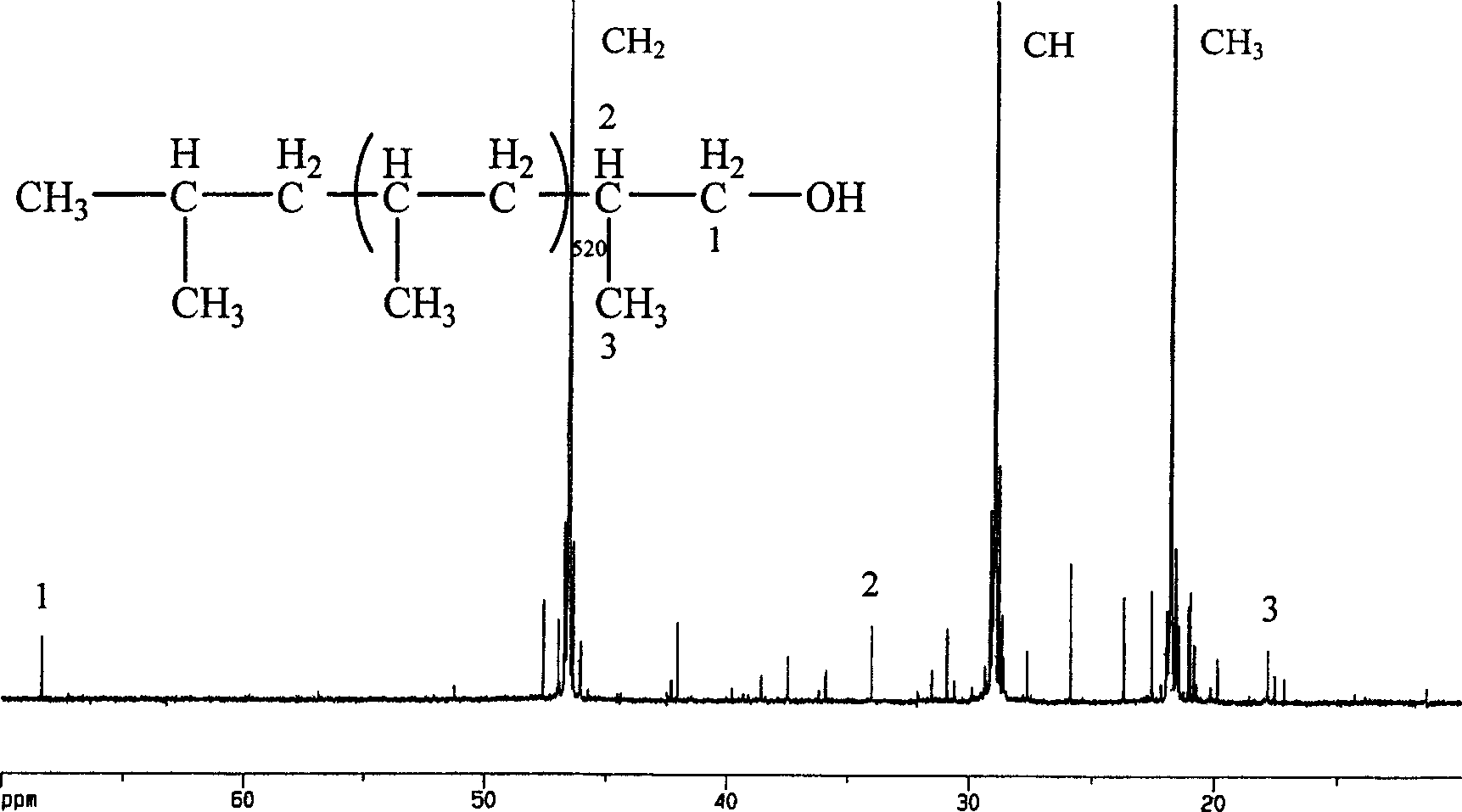Hydroxy terminated polypropylene and its preparing method
A technology of hydroxyl-terminated polypropylene and polypropylene, which is applied in the field of hydroxyl-terminated polypropylene and its preparation, can solve the problems of complex steps, decreased catalytic polymerization efficiency, and unsuitability for large-scale production and preparation.
- Summary
- Abstract
- Description
- Claims
- Application Information
AI Technical Summary
Problems solved by technology
Method used
Image
Examples
Embodiment 1
[0073] Catalyst: Dimethylsilyl bis(2-methyl-4-naphthyl-indenyl)zirconium dichloride
[0074] Cocatalyst: Methylalumoxane
[0075] Under an argon atmosphere, add 50mL of toluene and 1.8mL of 1.4mol / L methylaluminoxane cocatalyst into the polymerization reactor, and stir at 30°C for 10 minutes; then replace the argon with propylene gas three times, and keep the propylene gas The pressure is 0.1Mpa; then at 30°C, add 2.5×10 -6 The metallocene catalyst of mol, the mol ratio=1000:1 of methylaluminoxane cocatalyst and metallocene catalyst, 30 ℃ of stirring 30 minutes, propylene gas pressure is kept on 0.1Mpa in the polymerization process; The product was oxidized with oxygen for 2 hours, then added 6mL of 30% hydrogen peroxide and 20mL of 0.1g / mL sodium hydroxide aqueous solution, and carried out hydrolysis reaction at 50°C for 4 hours; then the reaction product was precipitated with excess 10wt% hydrochloric acid ethanol, filtered A white solid was obtained, which was thoroughly ...
Embodiment 2
[0077] Catalyst: Dimethylsilyl bis(2-methyl-4-naphthyl-indenyl)zirconium dichloride
[0078] Cocatalyst: Methylalumoxane
[0079] Under an argon atmosphere, add 50mL of toluene and 3.6mL of 1.4mol / L methylaluminoxane cocatalyst into the polymerization reactor, and stir at 30°C for 10 minutes; then replace the argon with propylene gas three times, and keep the propylene gas The pressure is 0.1Mpa; then at 30°C, add 2.5×10 -6 The metallocene catalyst of mol, the mol ratio=2000:1 of methylaluminoxane cocatalyst and metallocene catalyst, 30 ℃ of lower stirring 30 minutes, propylene gas pressure kept on 0.1Mpa in the polymerization process; The product was oxidized with oxygen for 2 hours, then 12mL of 30% hydrogen peroxide and 20mL of 0.2g / mL sodium hydroxide aqueous solution were added, and the hydrolysis reaction was carried out at 50°C for 4 hours; then the reaction product was precipitated with excess 10wt% hydrochloric acid ethanol, filtered A white solid was obtained, whic...
Embodiment 3
[0081] Catalyst: Dimethylsilyl bis(2-methyl-4-naphthyl-indenyl) zirconium dichloride Cocatalyst: Methylalumoxane
[0082] Under an argon atmosphere, add 50mL of toluene and 5.4mL of 1.4mol / L methylaluminoxane cocatalyst into the polymerization reactor, and stir at 30°C for 20 minutes; then replace the argon with propylene gas three times, and keep the propylene gas The pressure is 0.1Mpa; then at 30°C, add 2.5×10 -6 The metallocene catalyst of mol, the mol ratio=3000:1 of methylaluminoxane cocatalyst and metallocene catalyst, 30 ℃ of stirring 30 minutes, propylene gas pressure is kept on 0.1Mpa in the polymerization process; The product was oxidized with oxygen for 2 hours, then 18mL of 30% hydrogen peroxide and 30mL of 0.2g / mL sodium hydroxide aqueous solution were added, and the hydrolysis reaction was carried out at 50°C for 8 hours; then the reaction product was precipitated with excess 10wt% hydrochloric acid ethanol, filtered A white solid was obtained, which was thorou...
PUM
| Property | Measurement | Unit |
|---|---|---|
| molecular weight distribution | aaaaa | aaaaa |
Abstract
Description
Claims
Application Information
 Login to View More
Login to View More - R&D
- Intellectual Property
- Life Sciences
- Materials
- Tech Scout
- Unparalleled Data Quality
- Higher Quality Content
- 60% Fewer Hallucinations
Browse by: Latest US Patents, China's latest patents, Technical Efficacy Thesaurus, Application Domain, Technology Topic, Popular Technical Reports.
© 2025 PatSnap. All rights reserved.Legal|Privacy policy|Modern Slavery Act Transparency Statement|Sitemap|About US| Contact US: help@patsnap.com



